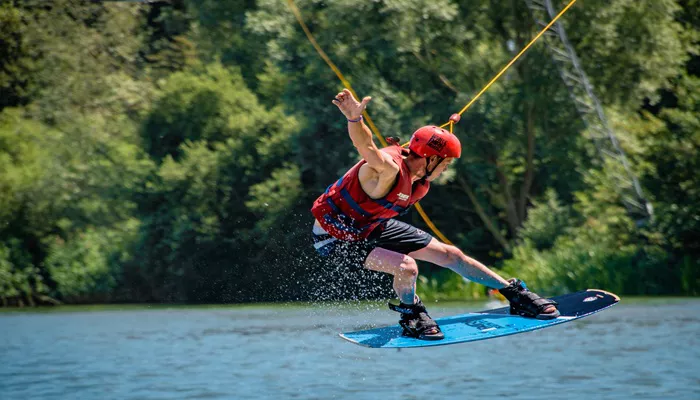Water skiing is an exhilarating and high-speed water sport that requires proper safety measures to ensure a secure and enjoyable experience. One of the most critical pieces of safety equipment for water skiing is the Personal Flotation Device (PFD). A well-chosen PFD can provide buoyancy, reduce the risk of drowning, and increase overall confidence on the water.
However, not all PFDs are suitable for water skiing, and understanding which type is best is essential for both beginners and experienced skiers.
In this article, we will discuss the different types of PFDs, which one is best suited for water skiing, key features to look for, safety regulations, and tips for selecting the right PFD for your needs.
Understanding PFD Types
Before selecting a PFD for water skiing, it’s important to understand the different classifications available. The U.S. Coast Guard (USCG) categorizes PFDs into five types based on their intended use, buoyancy level, and functionality.
Type I PFD – Offshore Life Jackets
Designed for rough or open water where rescue may take time.
Offers the highest buoyancy (22 lbs for adults).
Bulkier than other PFDs, making them impractical for water skiing.
Typically used for long-distance boating rather than high-speed water sports.
Type II PFD – Near-Shore Life Jackets
Suitable for calmer waters where rescue is expected quickly.
Offers less buoyancy (15.5 lbs for adults) than Type I PFDs.
May not keep an unconscious person face-up in the water.
Not recommended for water skiing due to limited mobility and comfort.
Type III PFD – Flotation Aids
The best choice for water skiing, wakeboarding, and similar water sports.
Provides good buoyancy (15.5 lbs for adults) while allowing full mobility.
Comfortable design with adjustable straps and flexible foam for a snug fit.
Available in various styles, including front-zip and side-entry designs.
Many are designed with impact protection to absorb shocks from falls.
Type IV PFD – Throwable Devices
Includes ring buoys and cushions designed to be thrown to a person in distress.
Not intended to be worn and not suitable for water skiing.
Typically used as backup safety equipment on boats.
Type V PFD – Special-Use Devices
Includes hybrid PFDs, inflatable life vests, and specialty designs.
Some Type V PFDs are approved for water skiing if specifically labeled.
Must be worn at all times to meet USCG safety requirements.
Key Features of a Water Skiing PFD
A good PFD for water skiing should have specific features that enhance safety, comfort, and performance. Here’s what to look for:
USCG Approval
Always choose a PFD that is USCG-approved for water sports.
Type III PFDs are the standard for water skiing.
Proper Fit and Sizing
A PFD should fit snugly but not restrict movement.
Adjustable straps help customize the fit for different body types.
Available in adult, youth, and child sizes to ensure appropriate buoyancy and comfort.
High-Impact Material and Durability
Made from durable neoprene or nylon to withstand frequent water exposure.
Neoprene vests offer a form-fitting design, while nylon vests are lightweight and breathable.
Reinforced stitching ensures longevity.
Freedom of Movement
Water skiing requires a full range of motion for balance and maneuverability.
A properly designed PFD should allow unrestricted arm and torso movement.
Thin, segmented foam panels enhance flexibility.
Quick-Release Buckles and Zippers
Secure closures prevent the PFD from slipping off during a fall.
A combination of zippers and adjustable straps ensures a tight and secure fit.
Quick-release mechanisms make it easy to take off when needed.
Bright Colors and Visibility
Bright colors (red, yellow, neon green, or orange) improve visibility in the water.
Reflective strips help rescuers spot a skier more easily in case of an emergency.
Safety Regulations And Requirements
Water skiing safety is regulated by boating laws that vary by state and country. However, general guidelines apply in most regions:
USCG Requirements
Every water skier must wear a USCG-approved PFD.
Type III PFDs are the standard for tow sports, including water skiing.
Inflatable PFDs are not permitted for water skiing.
State and Local Laws
Some states have age-specific PFD requirements for children.
Check local boating regulations before heading out on the water.
Operators towing skiers must also adhere to speed and safety regulations.
International Guidelines
Countries like Canada, Australia, and the UK have similar PFD regulations.
Always verify local requirements when skiing in international waters.
Choosing the Right PFD for Water Skiing
Selecting the right PFD depends on personal preference, skill level, and intended use. Here are some recommendations:
Best PFDs for Beginners
Look for a lightweight, Type III nylon PFD with adjustable straps.
Bright colors and a comfortable fit encourage confidence in the water.
Best PFDs for Advanced Skiers
Neoprene vests provide a snug, flexible fit with impact protection.
Thin, segmented foam panels enhance maneuverability.
Best PFDs for Competitive Skiing
High-performance vests with reinforced stitching and shock-absorbing foam.
Sleek, hydrodynamic design minimizes drag in the water.
Maintenance And Care for Your PFD
To ensure longevity and safety, proper maintenance of your PFD is essential.
Rinse After Use
Always rinse in fresh water after exposure to saltwater or chlorine.
Prevents material breakdown and prolongs durability.
Dry Properly
Air dry in a shaded area to prevent fading and material damage.
Avoid direct sunlight for extended periods.
Regular Inspection
Check for tears, loose straps, or damaged buckles before each use.
Replace PFDs that show significant wear and tear.
Conclusion
Choosing the right PFD for water skiing is crucial for safety, comfort, and performance. Type III USCG-approved PFDs are the best choice, offering the right balance of buoyancy, flexibility, and security. By understanding the different types of PFDs, essential features, and safety regulations, you can make an informed decision and enjoy a safe and thrilling water skiing experience. Always prioritize fit, visibility, and durability to ensure maximum protection on the water.

